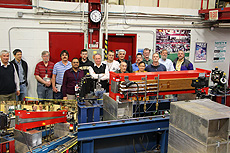Fermilab magnet team helps bring brighter beams to APS Upgrade Project at Argonne
 |
Argonne National Laboratory was attracted to the expertise of this Fermilab magnet team. The team recently developed a pre-prototype magnet for Argonne's APS Upgrade Project. Photo: Doug Howard, TD |
A magnet two meters long sits in the Experiment Assembly Area of the Advanced Photon Source at Argonne National Laboratory. The magnet, built by Fermilab's Technical Division, is fire engine red and has on its back a copper coil that doesn't quite reach from one end to the other. An opening on one end of the magnet's steel casing gives it the appearance of a rectangular alligator with its mouth slightly ajar.
"It's a very pretty magnet," said Argonne's Glenn Decker, associate project manager for the accelerator. "It's simple and it's easy to understand conceptually. It's been a very big first step in the APS Upgrade."
The APS is a synchrotron light source that accelerates electrons nearly to the speed of light and then uses magnets to steer them around a circular storage ring the size of a major-league baseball stadium. As the electrons bend, they release energy in the form of synchrotron radiation — light that spans the energy range from visible to X-rays. This radiation can be used for a number of applications, such as microscopy and spectroscopy.
In 2013, the federal Basic Energy Sciences Advisory Committee, which advises the Director of the Department of Energy's Office of Science, recommended a more ambitious approach to upgrades of U.S. light sources. The APS Upgrade will create a world-leading facility by using new state-of-the-art magnets to tighten the focus of the APS electron beam and dramatically increase the brightness of its X-rays, expanding its experimental capabilities by orders of magnitude.
Instead of the APS' present magnet configuration, which uses two bending magnets in each of 40 identical sectors, the upgraded ring will deploy seven bending magnets per sector to produce a brighter, highly focused beam.
Because the APS Upgrade requires hundreds of magnets — many of them quite unusual — Argonne called on experts at Fermilab and Brookhaven National Laboratory for assistance in magnet design and development.
Fermilab took on the task of designing, building and testing a pre-prototype for a groundbreaking M1 magnet — the first in the string of bending magnets that makes up the new APS arrangement.
"At Fermilab we have the whole cycle," said Fermilab's Vladimir Kashikhin, who is in charge of magnet designs and simulations. "Because of our experience in magnet technology and the people who can simulate and fabricate magnets and make magnetic measurements, we are capable of making any type of accelerator magnet."
The M1's magnetic field is strong at one end and tapers off at the other end, reducing the impact of processes that increase the beam size, producing a brighter beam. Because of this change in field, this magnet is different from anything Fermilab had ever built. But by May, Fermilab's team had completed and tested the magnet and shipped it to Argonne, where it charged triumphantly through a series of tests.
"The magnetic field shape they were asking for was a little bit challenging," said Dave Harding, the principal investigator leading the project at Fermilab. "Getting the shape of the steel to produce that distribution and magnetic field required some tinkering. But we did it."
Although this pre-prototype magnet is unlikely to be installed in the complete storage ring, scientists working in this collaboration view the M1 development as an opportunity to learn about technical difficulties, validate their designs and strengthen their skills.
"Getting our hands on some real hardware injected a dose of reality into our process," Decker said. "We're going to take the lessons we learned from this M1 magnet and fold them into the next iteration of the magnet. We're looking forward to a continuing collaboration with Fermilab's Technical Division on magnetic measurements and refinement of our magnet designs, working toward the next world-leading hard X-ray synchrotron light source."
—Ali Sundermier
|